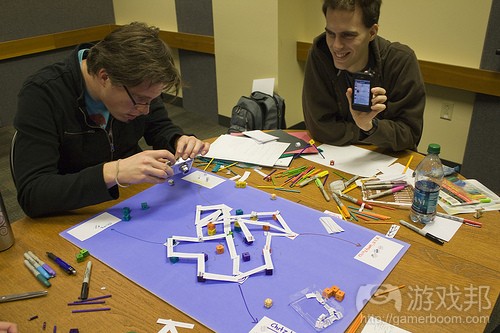简化游戏原型设计 保证调整方向的灵活性
作者:Gil
老实说,我既不是游戏设计领域的老手,也未曾发行过任何一款属于我自己的游戏。我将在这篇文章中阐述一些普遍存在的游戏设计误区,特别是对于那些设计新手来说很容易陷进去的麻烦。
有些误区我们已经很熟悉了,也有一些则是首次出现在游戏设计过程中,并且会不断衍生出新的误区。我这里说的是那些带有华丽部件的游戏原型。
当我们在玩这类型游戏时,可能会感到它是如此糟糕,如此可怕,甚至没有一点乐趣。
问题到底出在哪?好吧,其实有时候那些游戏并未真正具有可玩性,或许说,设计者仍然停留在收集前期反馈的阶段。
我并不是在反对制作华丽的游戏原型。我也曾经玩过几款非常不错但未曾正式发行的游戏。但是当你公开了一个好看的游戏原型后,这等于是向人暗示一个信息:你的游戏就要大功告成了。而人们便会开始对这款游戏报以期待,但是,如果当游戏正式问世之时你还停留在最初的开发阶段止步不前时,这款游戏便只会让玩家感到失望。
更重要的是,当你玩了2次以上的游戏发现自己改变了主意,你要如何在花了一周时间精心设计卡牌之后,用特定模块取代它们?为何在确定了随选列印的卡片后,你最后又决定以卡片骰子组合取代它们?
而这时你就更加需要小心谨慎。不要太过执拗于各种小成份。你可以使用数据库,电子数据表,甚至是邮件合并去创造一定数量的卡片。虽然这时候这些卡片看起来也许不尽人意,但是在接下来的几周时间里你至少可以修改3次的卡片。为何不多花点时间在这上面呢?
你的卡牌无需非常华丽。作为一名游戏测试者,如果我知道这是一款早期的游戏模型,我便会很乐意地花点钱去购买素描铅笔在活页纸上进行涂鸦。这是一个关于发挥你的灵感并想出该如何去实现灵感的阶段。
但是在这里我们还需注意一些区别的存在。有些设计者的灵感是来自于游戏的一些小部件,所以他们便会希望自己的游戏模型能够达到一定的质量。这也是为何他们会更加重视游戏的美学价值的原因。
的确,这一点都没错,因为灵感也很重要。但是我们也必须清楚早期游戏设计所存在的一些限制因素。应该尝试去平衡游戏原型设计,明确那些让你感兴趣以及在早期测试阶段较重要的高层次问题。
以下是你在进行首次游戏测试时需要避开的几个问题:
大量生产游戏需要多少成本?
卡片应该是华丽的还是简单的?
以下则是你在进行首次游戏测试时需要搞清楚的几个问题:
游戏是否有趣?
有趣在哪?
如果经历了X阶段游戏是否能够比在阶段Y更有趣?如果答案是肯定的,那是否还有必要经历Y阶段?
通过这几个问题可以发现,在早期测试阶段,我们无需过多地担心那些低级别问题,如成份的质量问题等。而更加需要关注高级别问题,就像游戏应该变成怎样?
你将会发现,游戏测试会把你指引到一个完全不同的方向上。假设有一款《Civ》游戏只有在第三阶段最有趣,这时候设计者是否就应该删掉剩余的游戏内容,而专心致力于完善这个有趣的阶段?
如果你在设计早期就一直执拗于一些错误的问题,并将自己牢牢地束缚在各种小细节中,你便无法快速适应游戏各个阶段的发展变化。你是一名游戏设计者,你可以主导游戏设计。所以在游戏设计的早期阶段要尽可能地保持灵活,如此才能够更加畅通无阻地创造出有趣的好游戏。
游戏邦注:原文发表于2009年2月4日,所涉事件和数据均以当时为准。(本文为游戏邦/gamerboom.com编译,拒绝任何不保留版权的转载,如需转载请联系:游戏邦)
Game design mistakes 4: The myth of the gorgeous prototype
By Gil
I won’t pretend to be an old hat at this game design business. For crying out loud, I’m not even published yet.
I also have to be a little careful here, because muses work in different ways. This post will say as much about me as it will about what I think is a very common game design mistake, especially among first-time designers.
I’ve seen it a couple of times now. Someone shows up to a game design group for the first time. He brings out his baby, and I mean his baby. I’m talking a lavishly-produced proto, with slobberingly-beautiful bits. Custom wood pieces. Everything handpainted. That sort of thing.
And then we play the game, and it’s awful. Miserable. Completely un-fun.
What went wrong? Well, sometimes it comes out that the game hasn’t really been played all that much. Just two or three times, and the designer is still in the early stages of collecting feedback.
I’m not against gorgeous prototypes. I’ve played some very good unpublished games with bits to die for. But when you put out a nice-looking prototype on the table, you’re telling your group that you have a game that’s close to done. People will expect it to be fun, and when it comes out that you’re still quite early in the process, it’ll throw them for a loop.
Even more importantly, why spend a week making the perfect board if, after two plays, you decide to use modular tiles instead? Why get quotes over print-on-demand cards if, after two more plays, you decide to ditch cards and go with dice instead?
Early prototypes are special. They’re “raw.” They’re in this weird quantum state of being a game and not being a game at the same time, because while they hold the promise and potential of being fun, they are almost always not fun to play.
You have to be guerilla at this time. Don’t spend a lot of time on the components. Use a database, spreadsheet, or even a mail merge to create cards on regular pieces of paper that you can slice with a guillotine and sleeve in ordinary Magic sleeves. They don’t look good, but hey, you’re going to be changing each card at least 3 times in the next few weeks. Why spend any more time on it than you have to?
Your board doesn’t have to be anything spectacular. As a playtester, if I know that this is an early-stage proto, I’m fine with playing with pennies on a pencil sketch on looseleaf paper. At this stage, it’s all about capturing your inspiration and figuring out what to do with it.
This is where I have to be careful. Some of you out there work a little differently. Some designers are inspired by game bits. They need their prototypes to be at a certain level of quality. That’s why they’re doing all this; part of the enjoyment, for them, is the aesthetic value of a nice-looking game.
Hey, there’s nothing wrong with that. A muse is a muse. But be aware of the limitations of an early game design. Try to strike a balance between making a proto that will keep your interest and one that will distract your attention from the critical early-stage, high-level questions.
Here are questions you shouldn’t be asking yourself during your first playtest :
How much will it cost to mass-produce this game?
How should the player pawns be shaped?
Should the cards be glossy or matte?
Here are questions you should be asking yourself during your first playtest:
Is this game fun?
Where is the fun?
Is there more fun in Phase X than Phase Y? If so, is Phase Y absolutely necessary?
You see where I’m going with this? During the early playtest, don’t worry about low-level issues like component quality. Concern yourself with high-level issues, like what the game’s actually going to look like.
Let the game flow. You may find that playtests will point you in a different direction than you originally intended. Like, the only fun part of your epic Civ game is the Phase 3 auction. In that case, maybe you should crop the rest of the game out, and work on a light/middleweight auction game instead?
If you ask the wrong questions too early, and bind yourself to your components, you won’t be able to respond rapidly to these sorts of developments. You’re the game designer. You have full control over where the design goes. Be as flexible as possible early on, and you’ll find less resistance on your way to a good, fun game.(source:/ingredientx)








































 闽公网安备35020302001549号
闽公网安备35020302001549号